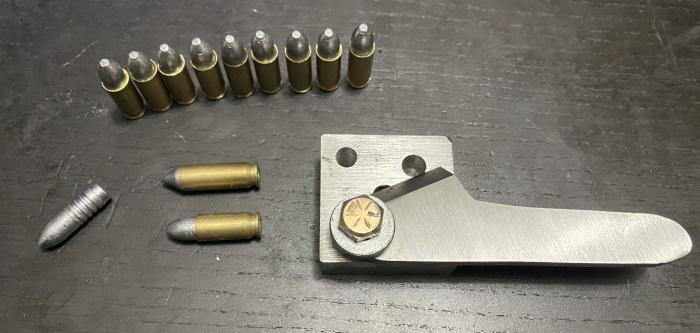The .277 Lee bullet mold arrived today, and I was casting bullets pretty quickly. That went quite well. Then it was simply a matter of cutting them to the right length to get a 70gr bullet; as cast the were 130gr. (They were also dead-on at .277 out of the mold.) Fortunately I Had a Cunning Plan.

The bullet cutter is an aluminum block with holes in it and a tool-steel blade attached. Put the cutter in the vice, drop the as-cast bullet in the hole and tap the cutter with a hammer. The end of the bullet shears off and goes back in the lead pot. The remaining bullet gets poked out from underneath with a 1/8″ punch. Works a treat. I bored two holes, one the correct length for a 70gr. bullet and one for a 60gr. bullet.
I made a number of 60 and 70gr bullets. I loaded the 60gr. bullets over 2.2gr of Unique, and the 70gr. bullets over 2.0gr of Red Dot. I set up my much-abused gel blocks, put the chronograph in front of them and fired some test shots and took an average of five shots. The results were, um, instructive.
70gr. Bullet / 2.0gr. of Red Dot
5 shots produced an average velocity of 996 fps. with an extreme spread of 44 fps. This makes 154 ft./lbs. Reasonably close to my 1100 fps. goal. Bullets penetrated 14-3/4″ average into the gel. Rifling marks were deep and clean. However I will not be developing this load. Of the five shots two primers got hole and one blew clean out of the case! Red Dot is not the right powder for this application; I used it because I am practically out of Unique.
60gr. Bullet / 2.2gr. of Unique
5 shots produced an average velocity of 1163 fps. with an extreme spread of 31 fps. This produces 180 ft./lbs. This is very close to my target of 188 ft./lbs. Bullets penetrated 14-15″ into the gel. Rifling marks were deep and clean. Good load; shame I’m almost out of Unique. Primers were fine.
Both loads locked the slide back on the empty magazine; I loaded one round at a time because of the lack of an extractor-spring. More load development will be forthcoming, but powder supplies are limited and I’m almost out of small pistol primers.
So it looks like I will have no trouble making my power target. The jury is out on whether I will be able to do it with a 70gr. bullet. Have to try some other powders when or if they become available. Until then I will be jealously guard my few remaining primers to that end.
Stay safe and take care,
Michael Tinker Pearce, 6 May 2022